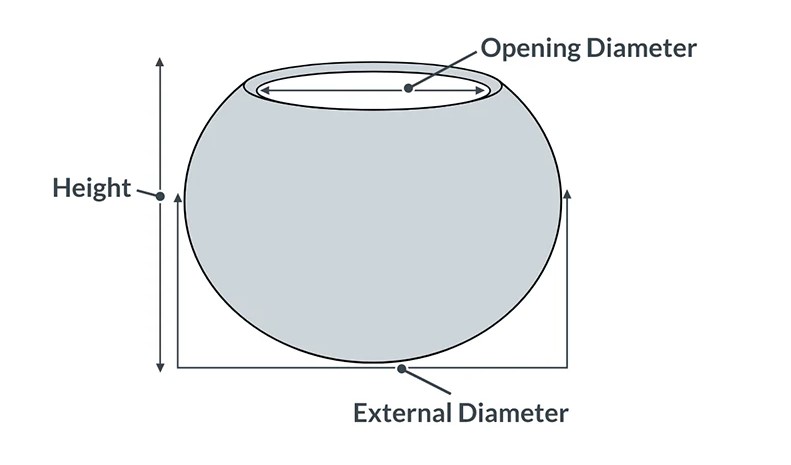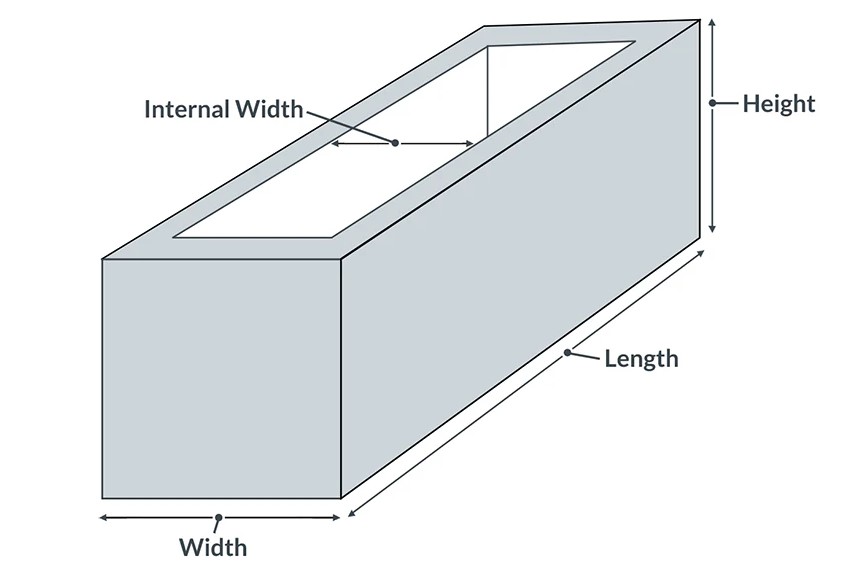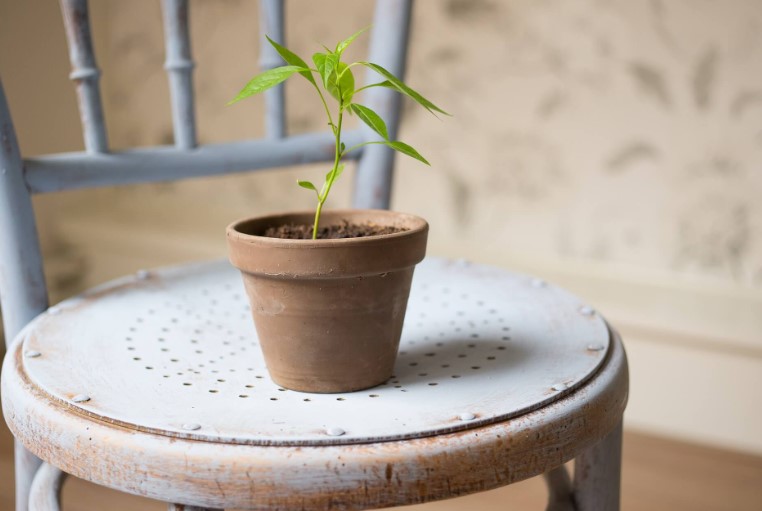Selecting the right-sized pot for your plants is crucial for their health and growth. An undersized pot can restrict root development, leading to nutrient deficiencies and stunted growth. Conversely, an oversized pot can retain excessive moisture, promoting root rot and other diseases. Accurately measuring your plant pots is essential to ensure your plants thrive.
This guide will help you understand how to accurately measure plant pot sizes in the UK, along with tips for selecting the best size for your greenery. Whether you’re an experienced gardener or a beginner, knowing how to measure pots correctly will enhance your gardening experience and contribute to the vitality of your plants.
Tools Needed for Measuring Pot Size
Measuring Tools
To accurately measure your plant pots, you’ll need a few essential tools:
- Measuring Tape: A flexible measuring tape is ideal for measuring the diameter and height of pots, especially for rounded pots.
- Ruler: A straight ruler can be helpful for measuring smaller pots or rectangular containers.
- Caliper: If you need precise measurements, especially for smaller pots, a caliper can provide accuracy in measuring diameter and height.
- Notebook and Pen: Keeping track of your measurements is essential, especially if you’re dealing with multiple pots.
These tools will help you obtain accurate measurements, which is crucial for selecting the right pot size.
Step-by-Step Guide on Measuring Plant Pots
Measuring Diameter
To measure the diameter of a round pot:
- Find the Widest Point: Place the measuring tape or ruler across the top rim of the pot. Make sure you measure at the widest point.
- Record the Measurement: If you are using a measuring tape, note down the measurement in centimeters (cm) or inches (in). For round pots, the diameter is the same regardless of where you measure around the rim.
For square or rectangular pots:
- Measure Width and Length: Measure the width and length of the pot’s top rim, noting each dimension separately.
- Average the Measurements: If the pot has a tapered shape, take an average of the width and length to get an approximate diameter.

Image source: hortology.co.uk
Measuring Height
To measure the height of a pot:
- Place the Ruler Vertically: Stand the ruler or measuring tape vertically alongside the pot.
- Measure from Base to Rim: Start at the base of the pot and measure up to the top rim. Be sure to keep the tape straight to ensure accuracy.
- Record the Measurement: Note down the height in centimeters or inches.

Image source: hortology.co.uk
Measuring Volume
To calculate the volume of a pot, you can use the following formula for a cylinder (for round pots):
Volume=π×(2d)2×h
Where:
- d is the diameter.
- h is the height.
- π is approximately 3.14.
For square or rectangular pots, use the formula:
Volume=l×w×h\text{Volume} = l \times w \times h Volume=l×w×h
Where:
- l is the length.
- w is the width.
- h is the height.
Convert your volume measurements into liters, if necessary, by noting that 1 liter equals 1,000 cubic centimeters (cc). This calculation helps in determining whether the pot can accommodate the root system of your plant adequately.
Choosing the Right Pot Size for Your Plants
Importance of Pot Size for Plant Health
Choosing the right pot size is crucial for healthy plant growth. Here’s why:
- Root Development: Plants require space for their roots to grow. A pot that is too small can stunt root growth, leading to poor plant health. Conversely, a pot that is too large can hold excess moisture, potentially causing root rot.
- Soil Moisture: The pot size influences soil moisture retention. Smaller pots dry out quickly, requiring more frequent watering. In contrast, larger pots may retain moisture for longer, which can be beneficial for certain plant types.
- Nutrient Availability: A well-sized pot allows for better nutrient absorption. If the pot is too small, plants may struggle to access necessary nutrients.

Image source: primrose.co.uk
Recommended Pot Sizes for Common Plants
Here are some general guidelines for selecting pot sizes for popular plants:
- Succulents: Ideal pot size is around 1-2L. Succulents prefer smaller pots that allow for good drainage and prevent overwatering.
- Herbs: A pot size of 2-5L is suitable for most herbs, allowing for ample root growth while retaining sufficient moisture.
- Houseplants: For medium-sized houseplants, a pot size of 5L is typically ideal. Larger houseplants may require pots of 10L or more.
- Shrubs and Trees: When planting shrubs or small trees, start with a pot size of 10L or larger, depending on the species.
These recommendations can vary based on the specific plant species and their growth habits. Always research the particular needs of your plants for the best results.
Tips for Shopping for Plant Pots
Where to Buy Pots in the UK
When shopping for plant pots, you have several options:
- Local Garden Centres: These are great places to find a variety of pot sizes and styles. Staff can often provide helpful advice on the best pots for your plants.
- Online Stores: Websites like Amazon, eBay, or specialist gardening websites offer a wide range of pots, often with customer reviews to help guide your purchase.
- DIY Stores: Stores like B&Q or Homebase typically have garden sections with a good selection of plant pots at competitive prices.
Comparing Pot Sizes
When shopping, it’s essential to compare sizes effectively:
- In-Store Shopping: If possible, bring a measuring tape to measure pots in-store. Use a reference item (like your hand) to visualize size.
- Online Shopping: Carefully check product descriptions for size specifications. Look for images that show the pot alongside commonly known items for a better sense of scale.
Conclusion
Measuring plant pot sizes correctly is an essential skill for any gardener. With the right tools and knowledge, you can ensure your plants have the space they need to thrive. Remember to consider the type of plant, its growth requirements, and how pot size influences factors like moisture retention and nutrient availability.
By following this guide, you can confidently select the perfect pot for your plants, contributing to a healthier, more vibrant garden.
Frequently Asked Questions (FAQs)
In the UK, plant pots are typically measured in liters (L) for volume, indicating how much soil they can hold. Common sizes range from small (1L) to larger pots (20L and beyond), helping gardeners select the right size for their plants.
To measure a plant pot, use a measuring tape or ruler:
Diameter: For round pots, measure across the top rim at the widest point. For square pots, measure the width and length.
Height: Measure from the base of the pot to the top rim.
Volume: Calculate using the formula for cylindrical (or rectangular) shapes, converting to liters if needed.
A 20L pot is typically about 30-40 cm (12-16 inches) in diameter and 35-45 cm (14-18 inches) in height. It’s suitable for larger plants or small trees, providing ample space for root growth.
Plant pots are generally measured at the top rim to ensure consistency, as this reflects the pot’s capacity for soil and roots. However, measuring the bottom can be useful for specific planting needs or when determining fit in a designated space.
